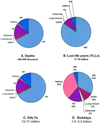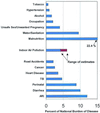National burden of disease in India from indoor air pollution
- PMID: 11087870
- PMCID: PMC27217
- DOI: 10.1073/pnas.97.24.13286
National burden of disease in India from indoor air pollution
Abstract
In the last decade, a number of quantitative epidemiological studies of specific diseases have been done in developing countries that for the first time allow estimation of the total burden of disease (mortality and morbidity) attributable to use of solid fuels in adult women and young children, who jointly receive the highest exposures because of their household roles. Few such studies are available as yet for adult men or children over 5 years. This paper evaluates the existing epidemiological studies and applies the resulting risks to the more than three-quarters of all Indian households dependent on such fuels. Allowance is made for the existence of improved stoves with chimneys and other factors that may lower exposures. Attributable risks are calculated in reference to the demographic conditions and patterns of each disease in India. Sufficient evidence is available to estimate risks most confidently for acute respiratory infections (ARI), chronic obstructive pulmonary disease (COPD), and lung cancer. Estimates for tuberculosis (TB), asthma, and blindness are of intermediate confidence. Estimates for heart disease have the lowest confidence. Insufficient quantitative evidence is currently available to estimate the impact of adverse pregnancy outcomes (e.g., low birthweight and stillbirth). The resulting conservative estimates indicate that some 400-550 thousand premature deaths can be attributed annually to use of biomass fuels in these population groups. Using a disability-adjusted lost life-year approach, the total is 4-6% of the Indian national burden of disease, placing indoor air pollution as a major risk factor in the country.
Figures


References
-
- Smith K R. Annu Rev Energy Environ. 1993;18:529–566.
-
- World Health Organization. Air Management Information System (AMIS) Geneva: World Health Organization; 1999.
-
- Holgate S T, Samet J M, Koren H S, Maynard R L, editors. Air Pollution and Health. San Diego: Academic; 1999.
-
- Lippmann M, editor. Environmental Toxicants. New York: Wiley-Interscience; 2000.
-
- Smith, K. R. & Jantunnen, M. (2001) Atmos. Environ. 35, in press.
Publication types
MeSH terms
Substances
LinkOut - more resources
Full Text Sources
Other Literature Sources
Medical

